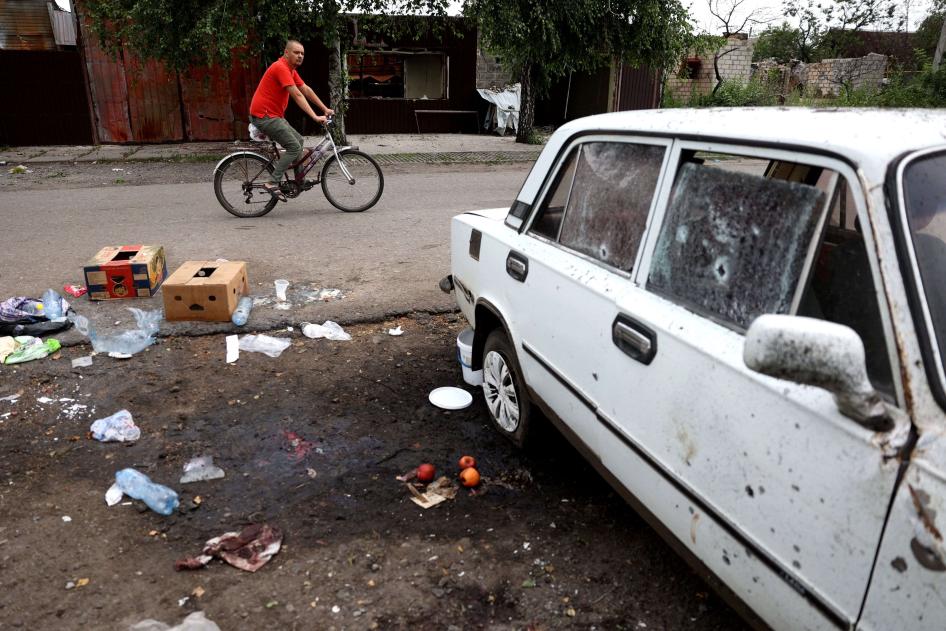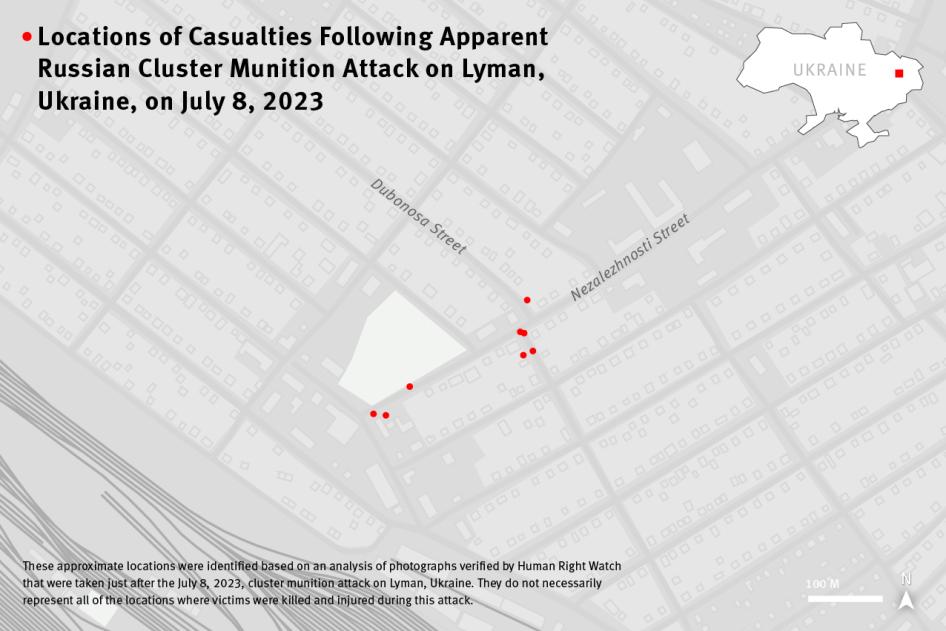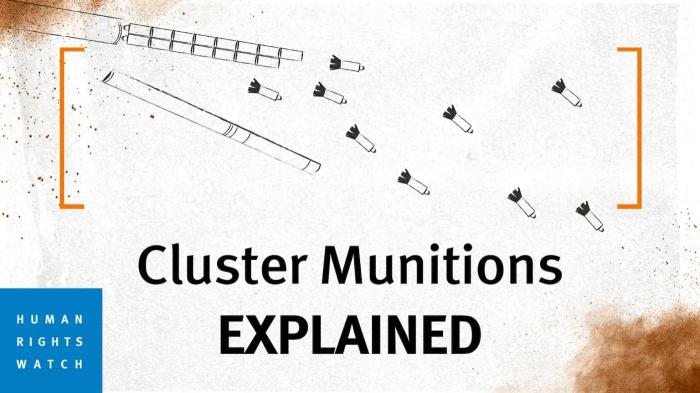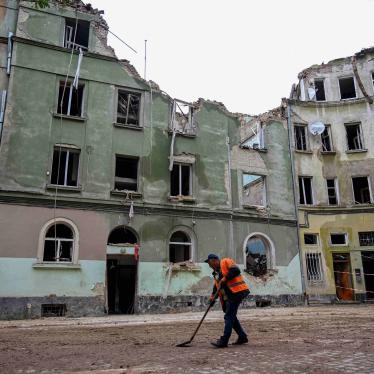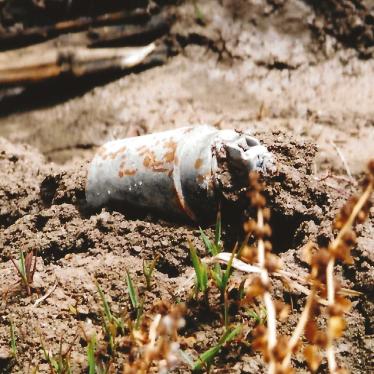(Kyiv, August 4, 2023) – Nine civilians were killed and more than a dozen injured in an apparent Russian cluster munition attack on July 8, 2023, in a residential district of the Ukrainian town of Lyman, Human Rights Watch said today.
Russia’s repeated use of cluster munitions since the start of its full-scale invasion of Ukraine in February 2022 has killed and wounded civilians, damaged civilian objects, and contaminated agricultural land. Cluster munitions are prohibited due to their indiscriminate nature and the long-term danger posed to civilians. The attack on Lyman should be investigated as a possible war crime.
“Despite Russia’s claims in recent weeks that it has never used cluster munitions in Ukraine, the list of deadly Russian cluster munition attacks runs long,” said Ida Sawyer, crisis and conflict director at Human Rights Watch. “This attack, if confirmed, once again demonstrates the Russian army’s contempt for civilians and the international legal restraints of war, as well as the deadly and indiscriminate nature of these weapons.”
At about 9:55 a.m. on July 8, explosions hit a residential area in the center of Lyman, in the Donetska region 15 kilometers west of Russian-occupied territory. Three witnesses, including two medics, as well as information posted online by Ukrainian authorities, indicated that at least nine civilians died during the attack and over a dozen others were injured, ranging in age from their 30s to their 70s. Human Rights Watch determined that the attack was carried out with a 9M55K-series Smerch cluster munition rocket containing 72 9N235 fragmentation submunitions.
Human Rights Watch interviewed five people by phone – including a person who arrived at the scene minutes after the attack, an explosive ordnance expert who analyzed remnants of the munition, civilian and military medics who responded to the attack, and a Lyman resident with knowledge of the affected neighborhood. Researchers also analyzed and verified 32 photos and videos posted online that were taken during and after the attack, satellite imagery of Lyman and surrounding areas, diagrams, photos of cluster munition remnants from the attack provided by Ukrainian authorities, and other official information about the attack.
The attack occurred at the intersection of Nezalezhnosti and Dubonosa Streets, where about 20 residents of the densely built-up neighborhood had gathered to trade dairy products and fresh produce from their gardens, as they did most mornings, two people interviewed said. The victims appeared to include people buying and selling items, and nearby pedestrians.
“I saw six people dead, both men and women,” a witness said. “We put 13 wounded people into ambulances and moved them to a hospital. There were wounds [to their] legs, stomachs, heads, and hands.” A woman with a serious head injury died en route to the hospital, a medic said. Two of the other injured people reportedly died the next day. The head of a hospital in Lyman said that 19 civilians were wounded in the attack, including some who sought treatment in the following days.
On the day of the attack, the regional war crimes prosecutor announced the death of 7 civilians in the attack, ages 52 to 71. The following day, the national police reported that the number of dead civilians had increased to nine.
Human Rights Watch received information that between 10 and 20 Ukrainian military personnel were also wounded in the attack. Human Rights Watch was unable to determine the exact number of military personnel who were in the area at the time of the attack, why they were there, or the exact number of military casualties.
People with the most severe injuries were transferred by military medical personnel to hospitals in the cities of Kramatorsk and Sloviansk, 20 and 30 kilometers from Lyman respectively. The head of the hospital in Lyman said he saw fragmentation injuries, bone fractures, and head wounds. “There were punctures and lacerations, and closed, open, and tangential wounds,” another doctor said. “The wounds were on limbs, heads, everywhere. The youngest person we assisted was a woman with open craniocerebral damage. She died on the way to a hospital in another city. She was between 35 and 37 years old.”
Cluster munitions can be delivered by aircraft or ground-launched missiles, projectiles, and rockets. They open in mid-air and disperse dozens and even hundreds of smaller submunitions, also called bomblets, over an area the size of a city block. Many submunitions fail to explode on initial impact, leaving duds that act like landmines, posing a threat to civilians for years and even decades.
Photos and videos shared with Human Rights Watch or posted online show fragmentation patterns embedded in asphalt and walls that are consistent with the dispersion of pre-formed metal fragments from submunitions. The remnants visible in the images, including rectangular black metal stabilization fins and pre-formed fragments of two sizes confirm that the attack was conducted with 9N235 fragmentation submunitions.
The range of 9M55K-series Smerch cluster munition rockets, between 20 and 70 kilometers, leaves Lyman well within the rocket’s range from Russian-occupied territory, with the front line about 15 kilometers from Lyman at the time of the attack. Earlier in July, the Russian Defense Ministry had claimed that it had used Smerch-rockets with unspecified warheads in Ukraine at least twice, including at least once in the vicinity of Lyman.
The neighborhood attacked on July 8 consists of low-rise residential buildings with a small garden square, a grocery store, and other shops. The car parts store was significantly damaged. The detonations of multiple submunitions also started a fire that destroyed three cars. The explosions and fragmentation also damaged three more cars and a single-story house close to the shop.
The attack targeted the center of the northern half of Lyman, which is bisected by what had been an important regional railway hub. Railway tracks and train stations can constitute legitimate military targets because they can be used by belligerents for military purposes. The Lyman railway system was destroyed during Russia’s full-scale invasion in 2022. Analysis of satellite imagery, photos and videos posted online, and witness accounts confirm that the railway remains out of service, so it cannot constitute a legitimate military target.
Lyman has been attacked frequently due to its strategic location since 2014, when Russia first occupied parts of Ukrainian territory. Lyman is very close to the front line but remains under Ukrainian forces’ control.
Despite Russia’s claims that it has not used cluster munitions in Ukraine, Human Rights Watch has documented multiple cluster munition attacks by Russian forces that caused significant civilian casualties. The cluster munitions attacks began in Vuhledar on the first day of the full-scale Russian invasion, followed by subsequent attacks in Kharkiv, Mykolaiv, Chernihiv, Kherson, and elsewhere. The Russian cluster munition attack on the crowded Kramatorsk train station on April 8, 2022, was one of the single deadliest incidents for civilians over the past 17 months.
The Ukrainian military has also used cluster munitions, including in the Izium area in 2022, according to Human Rights Watch research. In a widely criticized decision announced on July 7, 2023, United States President Joe Biden approved the transfer of stockpiled US cluster munitions to Ukraine. Human Rights Watch condemns any use or transfer of cluster munitions by any actor under any circumstances.
Neither Russia nor Ukraine, nor the United States has joined the 123 countries that have signed or ratified the 2008 Convention on Cluster Munitions. The convention comprehensively bans cluster munitions and requires the destruction of stockpiles, clearance of areas contaminated by cluster munition remnants, and assistance to victims of the weapons.
Regardless, the use of cluster munitions in areas with civilians makes an attack indiscriminate in violation of international humanitarian law.
Human Rights Watch co-founded and chairs the Cluster Munition Coalition, the global coalition of nongovernmental organizations working to eradicate cluster munitions.
“By apparently using an inherently indiscriminate weapon, Russia’s attack on Lyman caused civilian deaths, injuries, and property damage,” Sawyer said. “Both parties to the conflict should end their use of cluster munitions as these weapons are putting civilian lives at risk today and will do so for years to come.”
